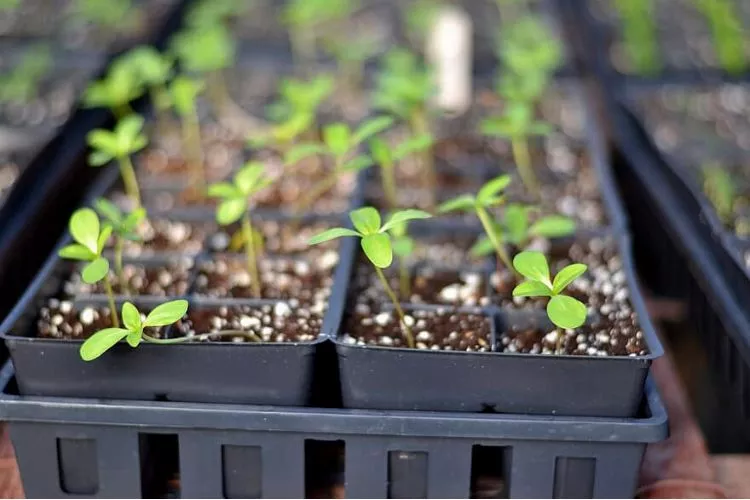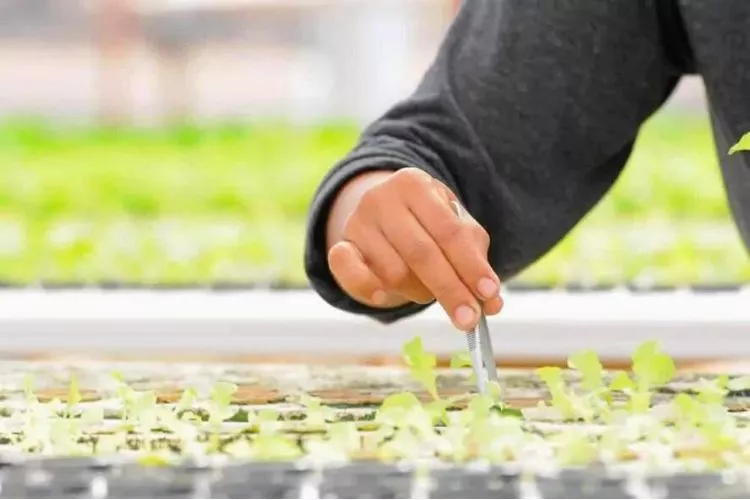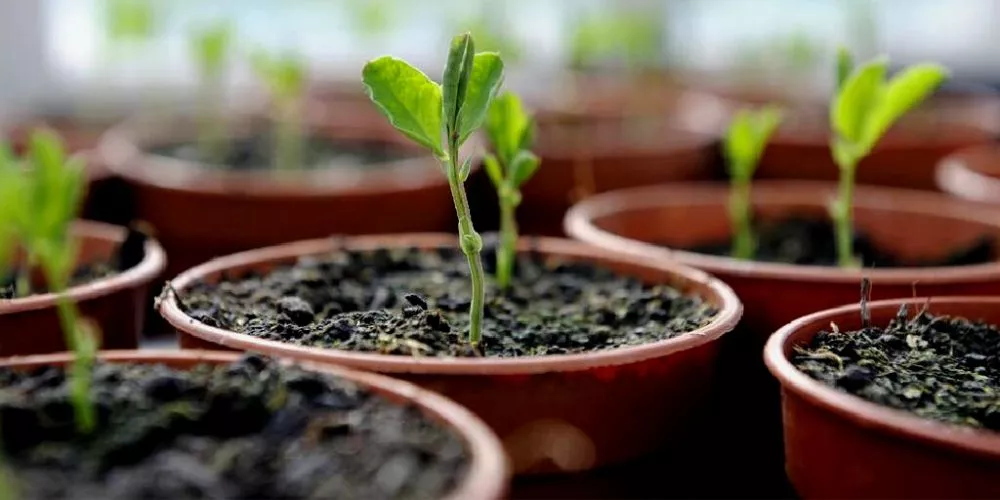Knowing exactly when to transplant seedlings in hydroponics into larger pots is one of the most important steps to master when growing hydroponically.
Mainly because this is the stage of their growth cycle where you want to strengthen their root system, upgrading them to larger pots will allow them the chance to burst out of their previously restricted root ball and become stronger.
When is the right time to transplant seedlings in hydroponics, though?
There is no universal time frame, as all plants grow differently and have different needs. There are, however, a few visual signs to look for in a plant that can help you decide when to begin transplanting your seedlings.
For example, you want them to be around 2-3 inches. Additionally, they should have at least 1-2 sets of true leaves.
The time frame can be anywhere between 1 and 3 weeks. If the transplant is not done correctly, the roots will curl into a ball, preventing them from functioning as they should.
Additionally, the plant will become stunted due to nutrient deficiency. Let’s look at how to navigate the proper procedure in the simplest way possible.

Table of Contents
Prerequisites before transplanting the seedlings into the hydroponic system?
Before you go ahead and upgrade your seedlings, there are a few things that you should do to prepare them. This includes minor checks and making sure the transplant conditions are perfect for the process.

Seed Checks and Preparation
- As discussed in the intro, ensure the seedlings are around 2-3 inches high and present a set of true leaves (usually 1-2). True leaves are those that pop out not long after an initial smaller set which is known as ‘cotyledon’ leaves. Some plants don’t push the first set out big enough, so they could be hard to spot. This is something that needs to be monitored carefully.
- Hardening your seedlings before transplanting is another important aspect. This can take between 1-2 weeks in the warmer sun of spring or 1-4 days in the cooler fall (autumn) months.
- If the seedlings have the true leaves but are becoming elongated and limp before transplant, they may require some attention. This usually means they are either not getting enough light or outgrowing their pot. If this is the case, you should transfer them prematurely.
Conditional Checks (Temperature, Moisture, and Weather)
- Extreme temperature swings could make it difficult to transfer on your preferred day. If this is the case, you can move the seedlings into a cell pot or a larger seedling tray when possible. This process is known as “pricking.”
- Keep an eye on the weather and avoid transplanting when the wind is strong or cold. Cold weather can cause transplant shock, whereas hotter temperatures require more watering.
- Always give the seedlings plenty of water before transplanting to ensure that the roots can take in as much moisture as possible. You can even use rainy weather to your advantage. Time your transplant with rainfall to ensure they are well and truly watered before, during, and after the transition.
Use the Moon
The specific phases of the moon have been used as a tool or guide by farmers for as long as time has been recorded.
It is said that transplanting certain types of seedlings during the moon’s second quarter phase (exactly 2 days before the full moon) is extremely beneficial to the size and characteristics of those plants.
Summer crops such as beans, melons, peppers, squash, and tomatoes have produced great results.
Another phase that sees results for transplanting produce such as carrots, potatoes, and onions is when the moon waxes or a little after a full moon.
The moon’s gravitational pull causes these seeming events. If you’re unsure about these practices, the first 2 prep steps will ensure a successful transplant nonetheless, which brings us to the next step. The process of transplanting.
When to transplant seedlings in hydroponics?
As I have already mentioned that the timespan isn’t universal for all plants types. So different plants will take their own sweet time. However, in most cases it would take anywhere between 1 and 3 weeks for the transplantation to be completed.
How do you transplant seedlings to hydroponics?
It’s recommended to make sure that this process is completed rather than methodically. This will ensure that the plants have every chance possible to survive.
It’s one of the trickiest times for a plant as it can go through shock due to its age.
You can either transplant it into the soil or larger hydroponic containers. This article will look at the process required to move hydroponic seedlings into the soil. A foolproof plan would look something like this…

What you will need?
- A gardeners spade
- A watering can or access to a hose.
- A dibber – this is generally an elongated tool used to not only poke a hole in the soil but also separate enough of the soil at a certain depth to allow for the root system to fit snugly.
- Your seedlings should have grown to the advised stage.
The Process
- Ensure that you have made all the appropriate checks before transplanting.
- Set your transplant trays up somewhere where you are comfortable to stand and work.
- Use your dibber to make a hole in the center of the soil of each container you will transplant to. Make sure that it is deep enough to accommodate the root system. The roots need to be able to be gently fed in as opposed to just stuffing them down. If you are unsure, you may want to measure each root system’s length.
- Some seedling containers are designed to be biodegradable. If this is the case, you won’t need to remove them from the container. Rather, use a gardener’s spade instead to dig a slightly larger hole to allow the pot to slot in snugly. Check out the root system of these types of containers. Quite often, they need a bit of a gentle shake to loosen them up before transplanting them.
- Once you have prepared the new transplant area, give all containers a good pre-watering using a soft pouring spray nozzle or watering can. Avoid gushing water, as it can dislocate the soil, and you’ll have to start again.
- Give the seedlings you’ll be transplanting a good watering before proceeding.
- Place your hand over the seedling, leaving space between your thumb and forefinger to allow the stem to stick through without becoming damaged.
- Flip the container upside down and gently free the seedling from its container while retaining as much of its original growing medium as possible. This will help reduce any possible shock.
- Gently lift over each seedling, one by one, and transplant them into their new homes in the prepared containers.
- Add good-quality soil around the base of the stem according to the plant’s requirements. Some plants need better drainage and/or a different pH level than others. Gently pack the soil down and around to firmly secure them into place.
- Give each seedling another generous amount of water. They need to be moist but not soaking to the point where the soil becomes dislodged.
Frequently Asked Questions (fAQs)
When can I transplant Rockwool seedlings?
Rockwool seedlings can be planted once the roots poke out from the bottom and sides. They will generally be around 2-3 inches tall by this stage. It’s best to go by the condition of the roots as a visual sign. All plants produce leaves at different times. The roots are what search for food and water. When they are mature, they are ready for a new home.
When can I transplant a solo cup?
The best visual guide for this growing method is the size of its leaves. Once the tips reach the outer edge of the cup, the plants should be upgraded into a larger container. If left too long in their original cup, the roots will start to ball upwards and inwards. This causes malnutrition and leads to stunted growth as a result.
How long should a seedling stay in a solo cup?
If grown under optimal conditions, a seedling should be stable enough to transplant from a solo cup to its new container after around 1-2 weeks. This is generally when the first true set of leaves has formed.
Does sugar water help transplant shock?
It’s debatable whether sugar water helps or hinders any form of transfer shock. However, it has been proven that a small amount is ok, but too much can cause a reverse osmosis. This can ultimately cause the plant to die of dehydration. It’s a fine line when it comes to achieving the perfect balance. Especially when there is much better quality, formulated products out there.
Should I give nutrients after the transplant?
Most plants require a decent dose of plant food just after transplanting them. They can receive enough via the soil provided. It all depends on how well-prepared the soil is. The best type of post-transplant food includes most types of dilute water-soluble fertilizer which should be added to the watering-in solution. Avoid using high-nitrogen fertilizers as they will cause root burn damage. Stick to dilutable high-phosphorus fertilizers when possible.
Should I fertilize seedlings after transplanting?
If the seedlings are around 3-4 inches tall, they will be strong enough to handle smaller amounts of plant food. It may take upto 2-3 weeks before they grow to that height.
Conclusion
The main principle of transplanting seedlings is simply to make sure that the root system is strong enough to begin its new journey in ‘real soil.’
This allows the plant to grow faster as the roots take in food and water. The bigger, stronger, and healthier they are, the more food and water they can take in.
Hence a better all-round plant. That’s why timing is everything when it comes to transplanting. We hope that this article has been informative.


